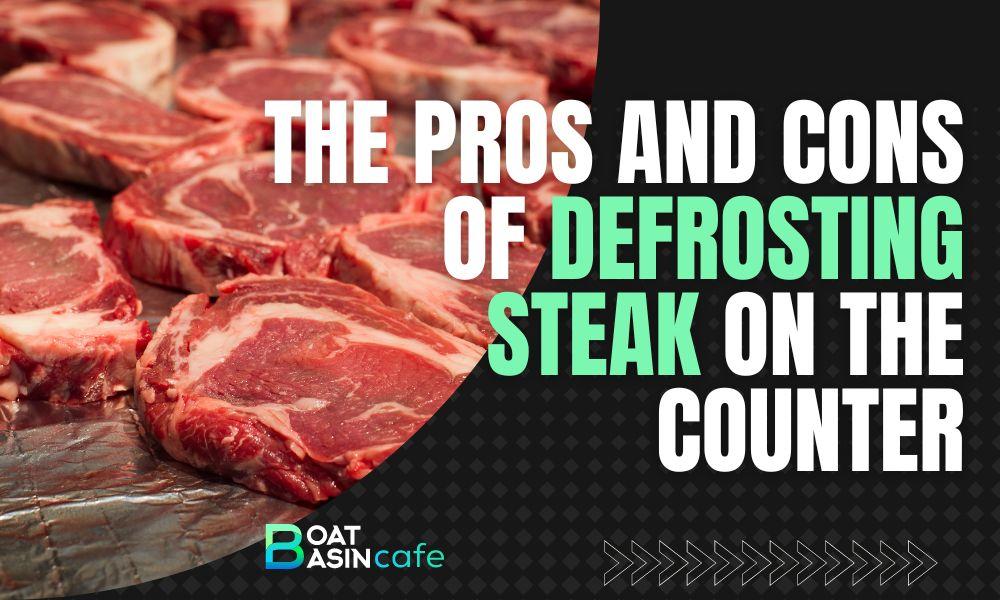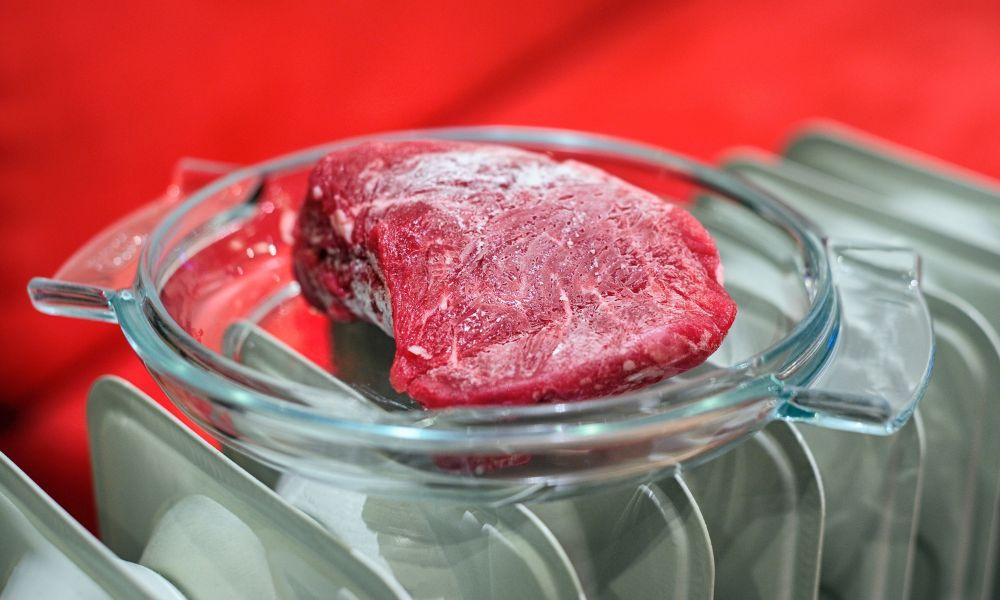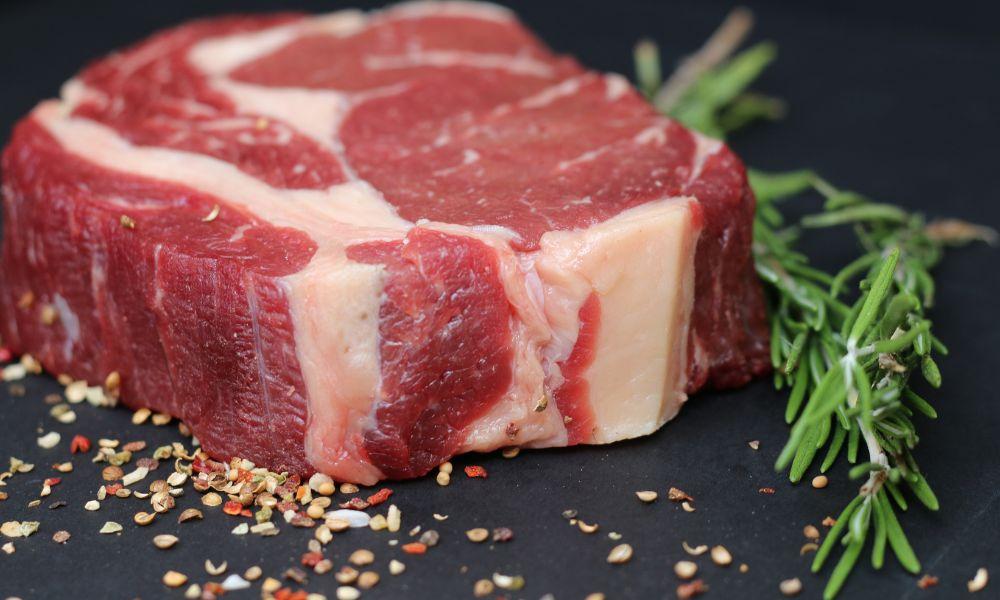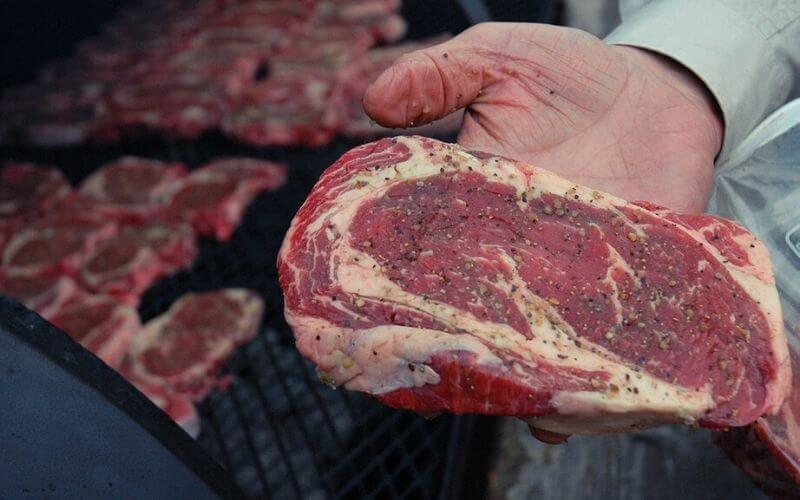Have you ever stood in your kitchen, holding a frozen steak, and wondered, “Can I defrost this on the counter without any problems?” You are not alone! In this comprehensive guide, we’ll unpack the pros and cons of defrosting steak on the counter while exploring alternative methods to ensure a delicious and safe meal.

Understanding the Defrosting Process
Before we dive into the pros and cons of defrosting steak on the counter, it helps to have a basic understanding of the defrosting process itself. If you’ve ever cooked a steak without thawing it first, you’re likely all too familiar with the uneven cooking and poor texture that usually results. Defrosting enables heat to penetrate the meat evenly, allowing for proper cooking and an ultimately succulent steak.
Improper thawing methods can cause the steak to lose moisture or promote the growth of harmful bacteria. Thawing steak on the counter might seem harmless, but understanding food safety guidelines is essential to ensure your delicious meal doesn’t lead to an unwanted case of food poisoning.
The Pros of Defrosting Steak on the Counter

Convenience and Time-Saving
Defrosting steak on the counter provides a certain level of convenience that other methods lack. For instance, when compared to refrigerator thawing, which requires foresight and hours of waiting, counter thawing is a much quicker alternative – perfect for those times when you forget to take out the steak earlier.
I can’t count how many times I’ve come home after a long day, ready to cook up a delicious meal, only to find the main ingredient – my beloved steak – still frozen. During those moments, having the fast and convenient option to thaw my steak on the counter is worth its weight in gold.
Even Thawing and Moisture Preservation
Defrosting steak at room temperature can promote even thawing and preserve moisture in the meat. Unlike microwave thawing, the counter method doesn’t deliver heat unevenly, meaning you won’t accidentally cook parts of the steak or experience moisture loss during the process. But, as we’ll discover later on, there are safe alternatives to consider that deliver premium quality and taste without jeopardizing your dinner or your health.
The Cons of Defrosting Steak on the Counter
Potential Risks and Bacterial Growth
While defrosting steak on the counter has its advantages, convenience comes at a cost. The most significant risk associated with this method is bacterial growth. Room temperature falls into the notorious “danger zone” (roughly between 40°F and 140°F), where harmful bacteria – such as Salmonella and E. coli – thrive and multiply rapidly. Thawing steak on the counter could place your meat right in the middle of this bacterial breeding ground.
During a particularly memorable summer barbecue, I decided to thaw my steaks on the counter, thinking it was perfectly safe. Little did I know, the warm weather only exacerbated the bacterial growth, and want to know the result? A ruined barbecue and a lesson learned the hard way. Check out our in-depth guide on defrosting frozen meat safely for all the necessary precautions on how to keep your meal barrel free.
Foodborne Illnesses
Due to the increased risk of bacterial growth, counter defrosting is more likely to lead to foodborne illnesses. Unsurprisingly, consuming bacteria-laden steak is a recipe for a miserable time – we’re talking diarrhea, nausea, vomiting, and fever – which can be especially dangerous for vulnerable populations, such as young children, the elderly, and pregnant women.
For those who prioritize food safety above all else, other defrosting methods – like refrigerator thawing or the cold water method – might be a better choice. Knowing the signs of bad steak can also help minimize the risk of sickness.
Best Practices for Defrosting Steak Safely

If you do decide to defrost your steak on the counter, there are a few best practices to follow to mitigate the risks associated with this method:
- Use appropriate packaging: Keep the steak sealed in the original packaging or place it in a leak-proof plastic bag to avoid exposing it to bacteria present in the environment.
- Ensure a clean counter and utensils: Wipe down the counter and any utensils used during the process, and wash your hands often – cross-contamination is a real concern.
- Monitor the thawing process: Check on your steak periodically and avoid leaving it on the counter for an extended period. It typically takes around 30 minutes to one hour to thaw one pound of meat at room temperature, after which the steak should be cooked immediately.
Stay tuned for more tips on best practices for safely defrosting steak and additional advice to prevent bacterial growth.
Alternative Methods for Defrosting Steak

When you’re raring to chow down on a delightful steak, but you’re not a fan of counter defrosting, fear not! There are less risky methods available that still deliver on quality, taste, and safety. Let’s look at some alternative processes for thawing your prized cut of steak.
Refrigerator Thawing
Refrigerator thawing is often regarded as the safest method for defrosting steak. This approach keeps your meat at a controlled temperature, well below the danger zone for bacterial growth. However, it requires a bit of foresight, as thawing in the fridge can take several hours or even a day, depending on the size of your cut.
Here’s how to thaw steak in the refrigerator:
- Place the steak on a plate or tray to catch any juices that may leak.
- Transfer the steak to the refrigerator, positioning it on the bottom shelf to prevent cross-contamination from potential leaks.
- Allow the steak to thaw for 4-7 hours per pound, depending on the thickness.
- Cook the steak within 3-5 days after thawing, or refreeze it without negative consequences.
This method delivers a safe and evenly thawed steak, ensuring quality taste and moisture preservation, essential for a perfect cut of steak like some delicious sirloin steaks in a crockpot.
Cold Water Thawing
For a quicker yet safe alternative to counter thawing, cold water thawing might be the perfect option. Thawing time is generally reduced, and exposure to harmful bacteria is minimized, keeping the meat cool and safe to eat afterward.
Give cold water thawing a try using these steps:
- Place the steak in a sealed, leak-proof plastic bag to prevent water contact.
- Fill a large bowl or basin with cold water and submerge the steak in it.
- Change the water every 30 minutes to maintain a cool temperature.
- Calculate the thawing time by allowing 30 minutes per pound.
You’ll be able to enjoy a quick and safely thawed steak without compromising on taste or receiving any unwanted foodborne illnesses.
Microwave Thawing
Microwave thawing is the fastest option for defrosting steak. However, it comes with the risk of uneven heat distribution, possibly resulting in partially cooked or dried-out meat. This approach is best suited for when you’re in a hurry and willing to trade quality for speed.
If you opt for microwave thawing, follow these steps:
- Remove any store packaging and transfer the steak to a microwave-safe dish.
- Use the defrost function on your microwave, setting the timer for 2-4 minutes per pound.
- Pause the process halfway through to turn and rearrange your steak to enhance even thawing.
- Cook your steak immediately after thawing to prevent bacterial growth.
Remember, microwave-thawed steak should not be refrozen as it might have already started cooking during the process.
FAQs
Can I defrost steak at room temperature overnight?
No, this increases the risk of bacterial growth, which may lead to foodborne illnesses.
How long does it take to defrost steak on the counter?
It typically takes around 30 minutes to one hour per pound, but it varies with the thickness and size of the steak.
Is it safe to cook partially thawed steak?
This is not recommended as you can’t ensure even cooking and proper heat distribution.
What are the risks of bacterial growth when defrosting steak on the counter?
The potential presence of harmful bacteria such as Salmonella and E. coli can lead to foodborne illnesses.
Can I defrost steak on the counter in hot weather?
Hot weather accelerates bacterial growth, so it is best to choose an alternative thawing method.
How can I defrost steak quickly without compromising safety?
Cold water thawing is the quickest safe method, taking 30 minutes per pound.
Can I refreeze steak after defrosting on the counter?
Only if you cook it first, as bacterial growth during counter thawing might contaminate the steak.
How does counter thawing compare to refrigerator thawing?
Counter thawing is faster, but it comes with increased bacterial growth risk, unlike fridge thawing.
Can I defrost steak on the counter if it’s vacuum-sealed?
Vacuum sealing doesn’t eliminate the risks associated with counter thawing, so it’s best to use another method.
Can I defrost other meats on the counter like chicken or pork?
It is unsafe to defrost any meat on the counter as all meats are susceptible to bacterial growth.
Conclusion
Now that you’ve explored the ins and outs of defrosting steak on the counter, along with alternative thawing techniques, it’s time to enjoy that mouthwatering meal you’ve been daydreaming about. Remember to prioritize food safety and consider the methods that best suit your situation. After all, a tasty, juicy steak is just one thawed cut away!
Reference links:
- www.foodsafety.gov/keep-food-safe/food-safety-by-events-and-seasons/defrosting-steak
- www.foodnetwork.com/grilling/grilling-central-steak/articles/how-to-defrost-steak-safely
- www.thekitchn.com/what-is-the-ideal-temperature-to-cook-steak-42122
- www.thespruceeats.com/how-to-thaw-steak-4688353
- www.epicurious.com/expert-advice/how-to-thaw-frozen-steak-article
- www.cookinglight.com/cooking-101/essential-ingredients/how-to-thaw-steak








